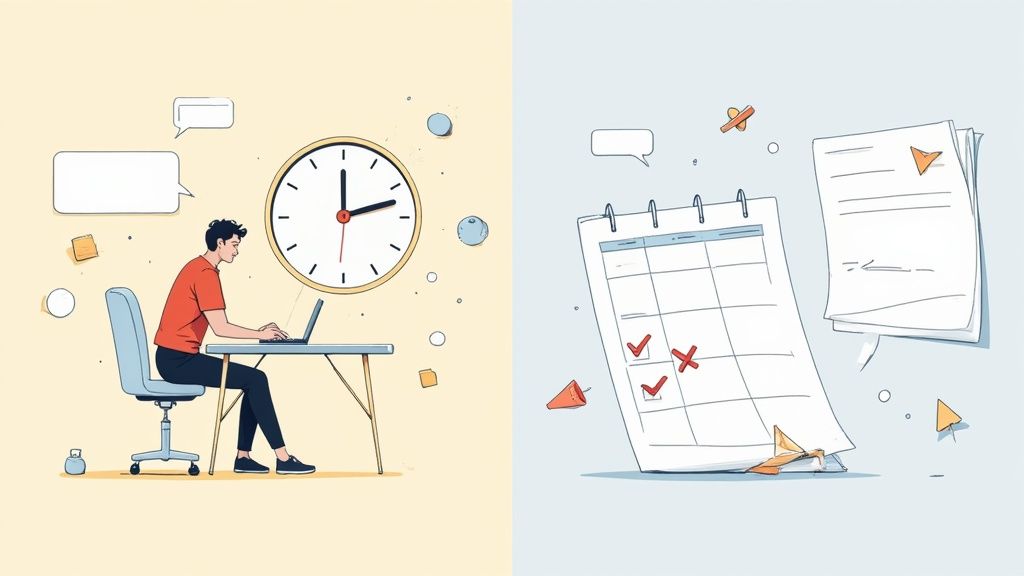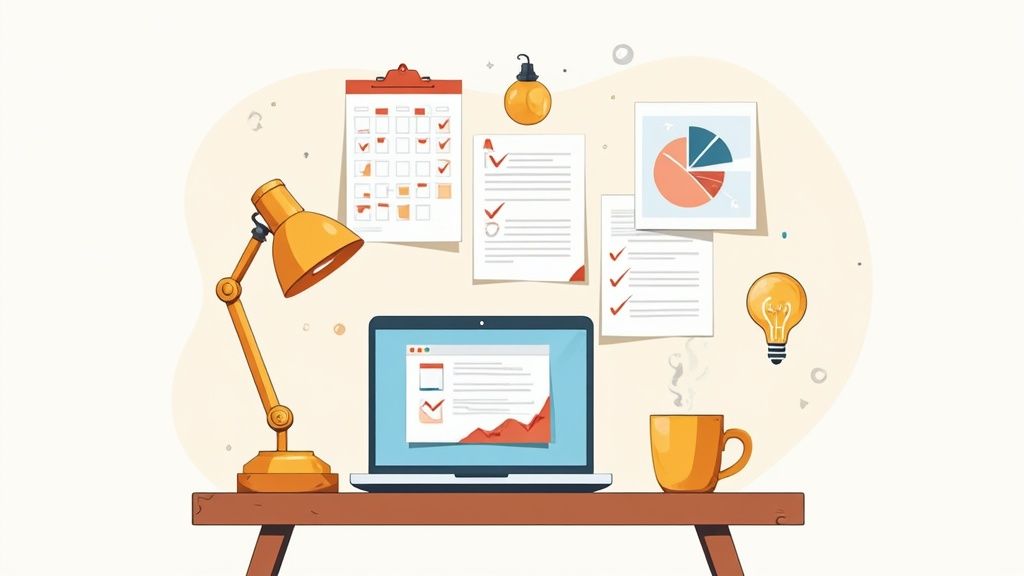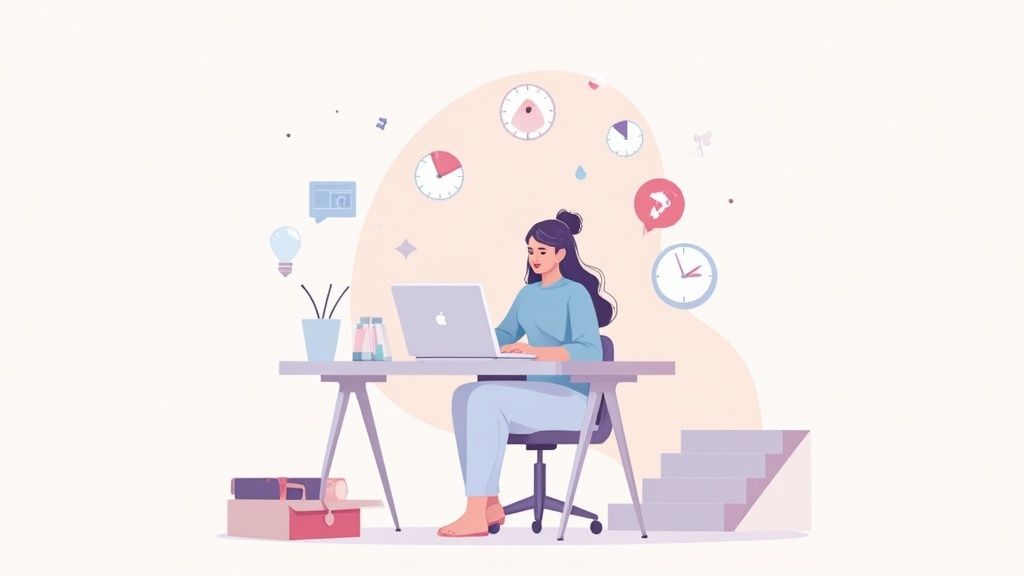Ever wish you could hit 'pause' on a live lecture or finally dig into a new skill in the middle of the night? That's pretty much asynchronous learning in a nutshell.
At its heart, asynchronous learning is a student-first approach where learning doesn’t have to happen in the same place or at the same time. It's a lot like your favorite on-demand streaming service, but for education—you get to decide when, where, and how fast you want to learn.
So What Is Asynchronous Learning Anyway?

Asynchronous learning ditches the rigid schedule of a traditional classroom. Instead of everyone jumping on a live video call at 9 AM sharp, you can dive into course materials whenever it works for you. We're talking pre-recorded video lectures, readings, online quizzes, and even group projects done through discussion forums over a few days.
This super-flexible model has become a huge part of modern online education. A 2021 report showed that 61% of undergraduate students had signed up for at least one online course, which just goes to show how much people dig flexible learning options. The magic of it is that while deadlines still keep you on track, the journey to get there is totally your own.
Asynchronous vs Synchronous Learning at a Glance
To really get what makes the asynchronous approach special, it helps to put it next to its counterpart: synchronous learning. One is live and in the moment, while the other is on-demand. This is a huge difference when you're exploring the world of distance learning education.
Here’s a quick breakdown to make it crystal clear.
| Feature | Asynchronous Learning (On-Demand) | Synchronous Learning (Real-Time) |
|---|---|---|
| Pacing | Self-paced; you control the speed | Instructor-led; everyone follows the same pace |
| Schedule | Flexible; grab materials anytime before deadlines | Fixed; you have to show up live at specific times |
| Interaction | Delayed via forums, email, or comments | Immediate via live chats and Q&A |
| Best For | Independent learners with busy schedules | Students who need structure and live interaction |
Basically, asynchronous learning hands the controls over to you. It's a style built for our modern reality, where juggling work, life, and education is just part of the deal.
It also plays nicely with other modern teaching methods. For instance, you can see how it supports different learning styles by checking out our guide on what is multimodal learning.
How Asynchronous Learning Actually Works
So, if the instructor and your classmates aren't in the same "room" together, how does any learning actually get done? It might sound a bit lonely, but a well-designed asynchronous course feels less like a solo mission and more like a cool, collaborative digital workspace. Think of it like a project team where people contribute at different hours, but everyone is still working together to build something awesome.
The whole setup isn't just a random pile of files thrown online. It's a carefully structured environment built on planned components, all designed to help you succeed at your own pace. Everything is usually managed through one central hub, making it easy to see exactly what you need to do and when.
The Core Components of an Asynchronous Classroom
At the heart of pretty much every asynchronous course is a Learning Management System (LMS). Think of the LMS as your virtual campus—a one-stop shop where you find all your course materials, turn in assignments, and connect with your classmates. You've probably heard of popular ones like Canvas, Blackboard, and Moodle.
Inside this digital hub, you’ll find a mix of resources that take the place of a traditional live classroom.
- Pre-recorded Video Lectures: Instead of being at a lecture at a specific time, your instructor records lessons you can watch (and rewatch) whenever you want. If you get stuck on a tough concept, you can just hit rewind. This is a huge plus for soaking up complex info at your own speed.
- Reading Materials and Resources: This is your digital library, packed with everything from textbook chapters and articles to interactive modules and case studies. All these materials are available 24/7, letting you dive deep whenever you’ve blocked out time to study.
- Online Discussion Forums: This is where the magic of collaborative learning happens, just not in real-time. Instructors will post interesting questions, and students chime in over the course of a day or even a week. It’s like a slow-motion, thoughtful conversation where you have time to really think about the topic and write a great response before posting.
The real power of asynchronous learning is that it lets you think things through. Instead of feeling pressure to respond instantly in a live discussion, you get the space to process information, form your own thoughts, and contribute in a more meaningful way.
Keeping Everyone Connected and on Track
Just because there are no set class times doesn't mean it's a total free-for-all. A great asynchronous course is built around a clear structure and good communication to keep everyone from feeling disconnected or lost.
Instructors usually set up courses with a clear weekly or modular flow. You'll have regular deadlines for assignments, quizzes, and discussion posts to make sure you stay on pace with the material. This structure gives you the accountability you need to get through the course successfully.
On top of that, communication isn't just stuck on discussion boards. Instructors offer support through email, scheduled virtual office hours, and detailed feedback on assignments. This makes sure that even though you're learning on your own schedule, you’re never truly on your own. It’s a model built for independence but backed by plenty of connection.
Why People Are Choosing Asynchronous Learning
The recent boom in online education isn't just a passing fad. It's a direct answer to what today's learners really need. People are actively picking asynchronous learning because it fits into the messy, unpredictable reality of their lives, putting them back in the driver's seat of their own education.
Think about it for a second. Instead of forcing your life to revolve around a rigid class schedule, you can weave learning into the pockets of time you already have. For a working parent, that might mean diving into coursework after the kids are in bed. For a full-time employee, it could mean mastering a new skill during lunch breaks.
The Power of Self-Paced Progress
One of the biggest draws of this style is being able to learn at your own speed. In a traditional classroom, the teacher has to set a pace that works for the "average" student, which often leaves some people behind and holds others back. With asynchronous learning, you're the one in control.
If a concept clicks right away, you can breeze through it and move on. But if a topic is giving you trouble, you have the freedom to pause, rewind a lecture, or spend a whole afternoon on a single chapter until you feel good about it. This personalized approach often leads to a much deeper and more lasting understanding of the material.
The real beauty of this model is that it respects individual learning journeys. It gets that everyone absorbs information differently and gives you the tools to learn in the way that works best for you, not just the way that's most convenient for a group.
The global shift toward this model is impossible to ignore. The eLearning industry is on track to hit around $400 billion by 2026, mostly fueled by this demand for flexible, self-paced options. This isn't just about convenience, either. It’s about getting better results. Studies have found that 84% of students prefer learning at their own pace, and in some cases, retention rates can be up to 60% higher than in traditional face-to-face settings. You can discover more insights about the eLearning market growth to see just how big this movement has become.
A Look at the Building Blocks
The awesome flexibility of asynchronous learning is made possible by a few key digital tools working together.

This visual breaks down the core elements—like on-demand video lectures, online discussion forums, and the central Learning Management System (LMS)—that form the backbone of a typical asynchronous course. These are the tools that power self-paced education, giving you access to everything you need, exactly when you need it.
Common Challenges and How to Beat Them

Learning on your own time sounds perfect, right? But let’s be real—it comes with its own unique set of hurdles. The very freedom that makes asynchronous learning so appealing can also be its biggest weakness, making it tough to stay engaged and on track.
The great news is that these challenges aren't deal-breakers. Far from it. With a few smart strategies, you can easily handle the common pitfalls and make your flexible learning journey a huge success.
Tackling the Feeling of Isolation
One of the first things people notice is the silence. When you're not in a live class, it's easy to feel like you're learning in a vacuum, which can be a real motivation killer for a lot of us.
The trick is to be intentional about making connections. Don't just be a wallflower in the discussion forums—jump in! Ask thoughtful questions, reply to your classmates, and start a real conversation. You can even take it a step further and organize a virtual study group to hash out tough topics over a video call. A little proactive effort here makes a world of difference in feeling like you're part of a community.
Winning the Battle Against Procrastination
Procrastination is the undisputed champion of asynchronous learning problems. Without a 10 AM lecture forcing you out of bed, the "I'll get to it later" mindset is incredibly tempting. Next thing you know, you’re a week behind with a mountain of assignments staring back at you.
The secret to beating procrastination isn't waiting for a magical burst of motivation. It's about building a system so you don't have to rely on it. A solid routine is your best defense against the "later" trap.
To stay ahead of the game, you have to create your own structure. Here are a few tried-and-true tips to keep the momentum going:
- Block out study time: Treat your learning sessions like legit appointments. Schedule them in your calendar and guard that time like a hawk.
- Break down big tasks: Staring at an entire module can feel overwhelming. Chop it up into smaller, bite-sized goals like, "watch one video lecture" or "finish the Chapter 5 quiz."
- Set mini-deadlines: Don't let the final due date be your only guide. Create your own weekly deadlines to keep yourself moving at a steady, manageable pace.
Getting Help When You Need It
So, what happens when you’re totally stuck on a concept and the instructor isn't there in real time? This is a valid concern, but asynchronous courses are built for it. Your instructor is still very much available to help—the communication just works a little differently.
When you reach out, be as clear and specific as you can in your email or forum post. Instead of a vague, "I don't get it," try something more pointed, like, "I'm having trouble with the 'supply and demand' example on slide 12. Could you explain the elasticity part in another way?" This gives your instructor exactly what they need to give you a fast, helpful answer.
For recorded lectures, having a transcript can be a lifesaver for finding these specific points of confusion. You can see just how simple it is to generate them with tools that offer AI-powered audio to text conversion.
Asynchronous Learning in the Real World
Asynchronous learning isn't just some theory; it's happening all around us, totally changing how we pick up new skills and knowledge every single day. You can see it everywhere, from university programs to company training and even the way we learn new hobbies. It's the quiet force driving a massive global shift in how education is made and consumed.
The most obvious place you see this is in higher education. Think about it—top-tier universities now offer entire degree programs online, built on an asynchronous foundation. This has thrown the doors wide open for people who could never have gone to traditional classes, like working parents or professionals living thousands of miles from campus, letting them earn a bachelor's or master's degree on their own time.
Asynchronous Learning at Work and Play
The corporate world caught on fast. Instead of pulling a whole department into a conference room for a week-long orientation, companies now use self-paced onboarding modules. New hires can get up to speed on company culture, software, and their specific duties whenever it works best for them.
This flexibility is a game-changer for training global teams scattered across different time zones, getting rid of logistical nightmares. The proof is in the pudding: a City Square Associates survey found that a whopping 87% of asynchronous learners felt they gained new skills they could immediately use at work.
And it doesn't stop at the office. Platforms like Coursera, Skillshare, and Khan Academy are household names built entirely on this model, bringing learning to millions.
What does asynchronous learning mean here? It's the simple, powerful idea that anyone can learn anything—from watercolor painting to data science—without ever setting foot in a live class. You just log on, hit play, and move at a pace that feels right.
Why It Works So Well
The real-world success of asynchronous learning boils down to one thing: adaptability. It meets people right where they are, slotting perfectly into the messy, unpredictable schedules of modern life.
You’ll find it in all sorts of places:
- University Degrees: Fully online programs from major schools.
- Corporate Training: Employee onboarding and ongoing professional development.
- Skill-Based Platforms: Learning new skills on sites like Udemy.
- K-12 Education: "Flipped classrooms" where kids watch lectures at home and use class time for hands-on work.
This model has proven time and again that powerful, effective education doesn't depend on everyone being in the same room at the same time.
Your Guide to Success in Asynchronous Courses

Ready to make asynchronous learning work for you? Whether you're a student tackling your first online course or an instructor designing one, success isn't a given. It all comes down to a few key strategies. This is about more than just logging on; it's about building a system that helps you focus, stay engaged, and actually understand the stuff.
Think of this as your playbook. With the right game plan, you can turn the freedom of self-paced learning from a source of stress into your biggest strength.
Tips for Learners
As a student, you're in the driver's seat. The trick is to build a structure that keeps you motivated and on track, especially when no one is looking over your shoulder.
- Create a Dedicated Study Zone: Find a spot in your home that's just for learning. When you physically separate your workspace from where you chill out, you're telling your brain it's time to get down to business.
- Time-Block Your Schedule: Look at your week ahead and carve out specific, non-negotiable slots for your coursework, just like you would for a regular class. This simple habit builds a routine and keeps procrastination from taking over.
- Engage Actively: Don't just lurk in the discussion forums—jump in! Asking questions and replying to your classmates helps build a sense of community and forces you to process the material on a much deeper level. Mastering these and other effective student learning strategies can truly make or break your experience.
Best Practices for Instructors
For educators, putting together a great asynchronous course is way more than just uploading a few videos. The real goal is to build an intuitive, supportive environment where students feel connected and motivated to succeed on their own.
A huge part of that is learning how to create training materials that truly engage and educate, because in a self-paced setting, your resources do a lot of the heavy lifting.
Success in asynchronous learning all comes down to intentional design. A great course anticipates what students might need, provides clear ways to communicate, and creates a sense of community even without real-time interaction.
Here are a few pointers to help you build a standout course:
- Set Crystal-Clear Expectations: From day one, give students a detailed syllabus, a clear schedule with all deadlines, and simple instructions for every single assignment. When they know exactly what's expected, they can stop worrying and start learning.
- Design for Engagement: Nobody wants to sit through a 90-minute video lecture. Break down long lessons into shorter, bite-sized videos. Mix up your media—use text, video, interactive quizzes, and podcasts—to keep the material fresh and appeal to different learning styles.
- Provide Timely and Constructive Feedback: Since you don't have that immediate back-and-forth of a live class, your written feedback becomes super important. Be specific, encouraging, and quick with your comments to keep students motivated and point them in the right direction.
Got Questions About Asynchronous Learning?
If you've still got a few questions, you're not alone. Let's run through some of the most common things people wonder about when they first hear about asynchronous learning.
Think of this as your quick-and-dirty FAQ to clear up any lingering confusion. We'll keep it simple.
Is It Easier Than a Traditional Class?
That’s the million-dollar question, isn't it? The short answer is no—it's just a different kind of hard. Asynchronous learning puts a huge emphasis on self-discipline and time management.
You get more flexibility, but the workload—the reading, the assignments, the projects—is exactly the same as in a traditional class. The difficulty of the material itself doesn't change one bit.
The challenge shifts from showing up on time to managing your own time. It's not about being "easier"; it's about needing a different set of skills to really succeed.
Without a fixed schedule, it's all on you to keep up. This style is perfect for people who are organized and self-motivated, rewarding personal responsibility over just being in a certain place at a certain time.
How Do You Handle Grades and Track Progress?
Grading in an asynchronous course isn't all that different from a regular class. Your progress is usually tracked through a mix of assignments, projects, quizzes, and how much you contribute to online discussion forums.
Instructors set firm deadlines for everything to keep the whole class moving forward at a steady pace. You’ll get feedback and see your grades right in the Learning Management System (LMS), so you always have a clear picture of how you're doing and can keep an eye on your progress week by week.
Is Asynchronous Learning Cheaper?
It definitely can be! While tuition costs are all over the place, asynchronous programs often cut down on a lot of the other expenses tied to education. You get to skip costs like daily commutes, on-campus housing, or buying physical textbooks, since most materials are digital.
For a lot of people, these savings add up and can seriously lower the overall cost of their education, making it a much more accessible option.
Ready to make your educational content more accessible? With podcast-generator.ai, you can convert your course materials, articles, and study guides into engaging audio episodes in minutes. Turn any text or video into a podcast that students can listen to anytime, anywhere. Create your first episode for free at https://podcast-generator.ai.
